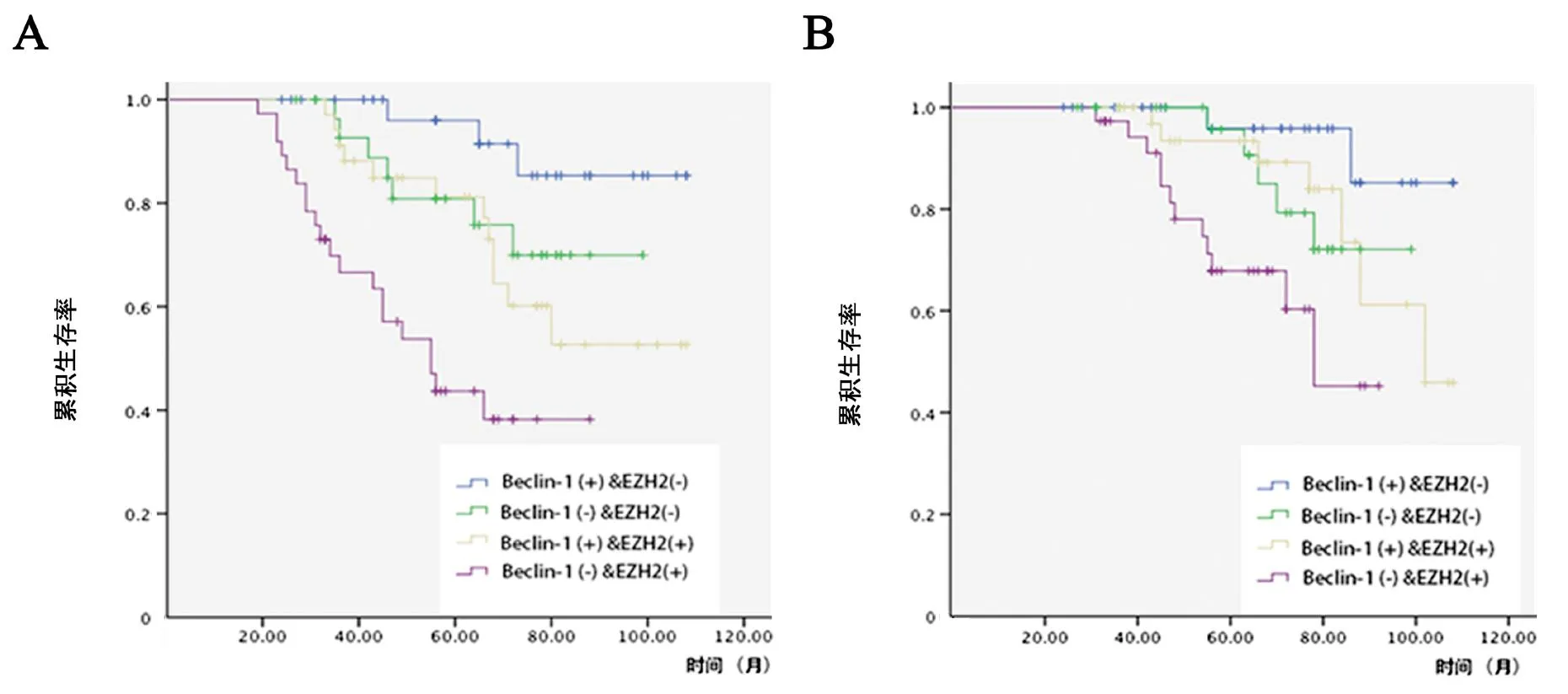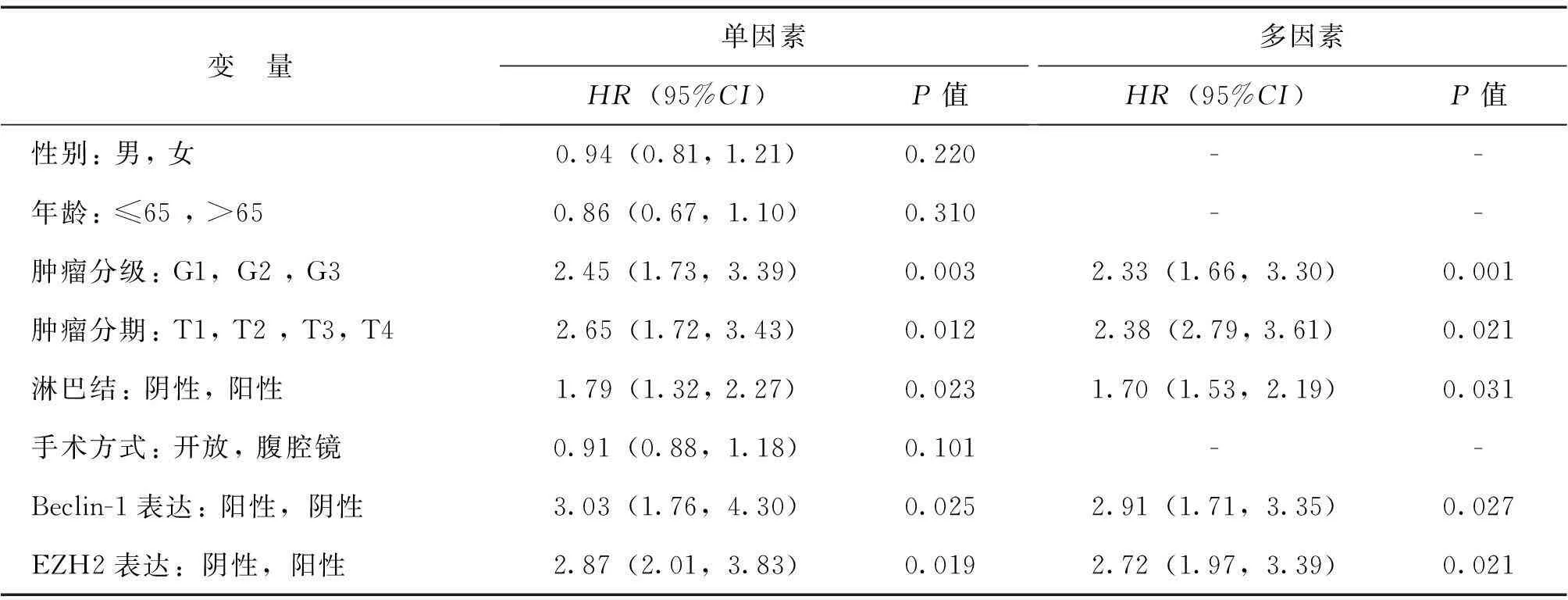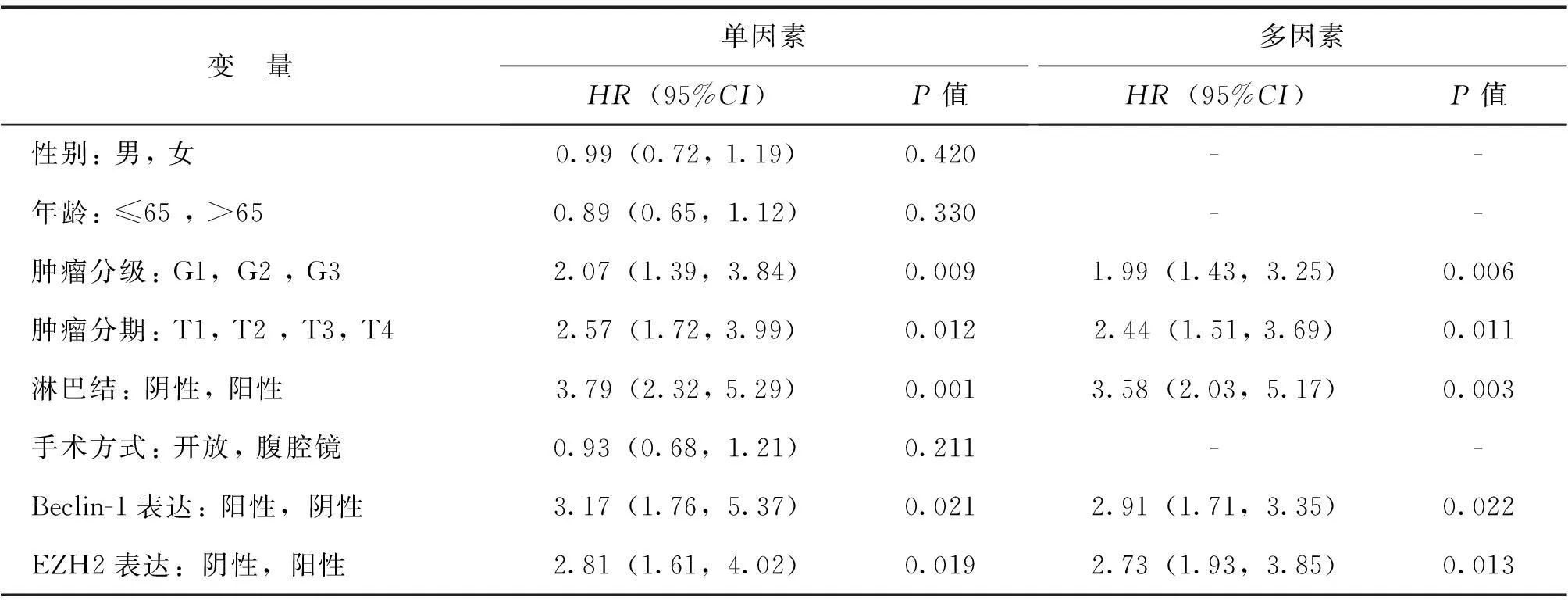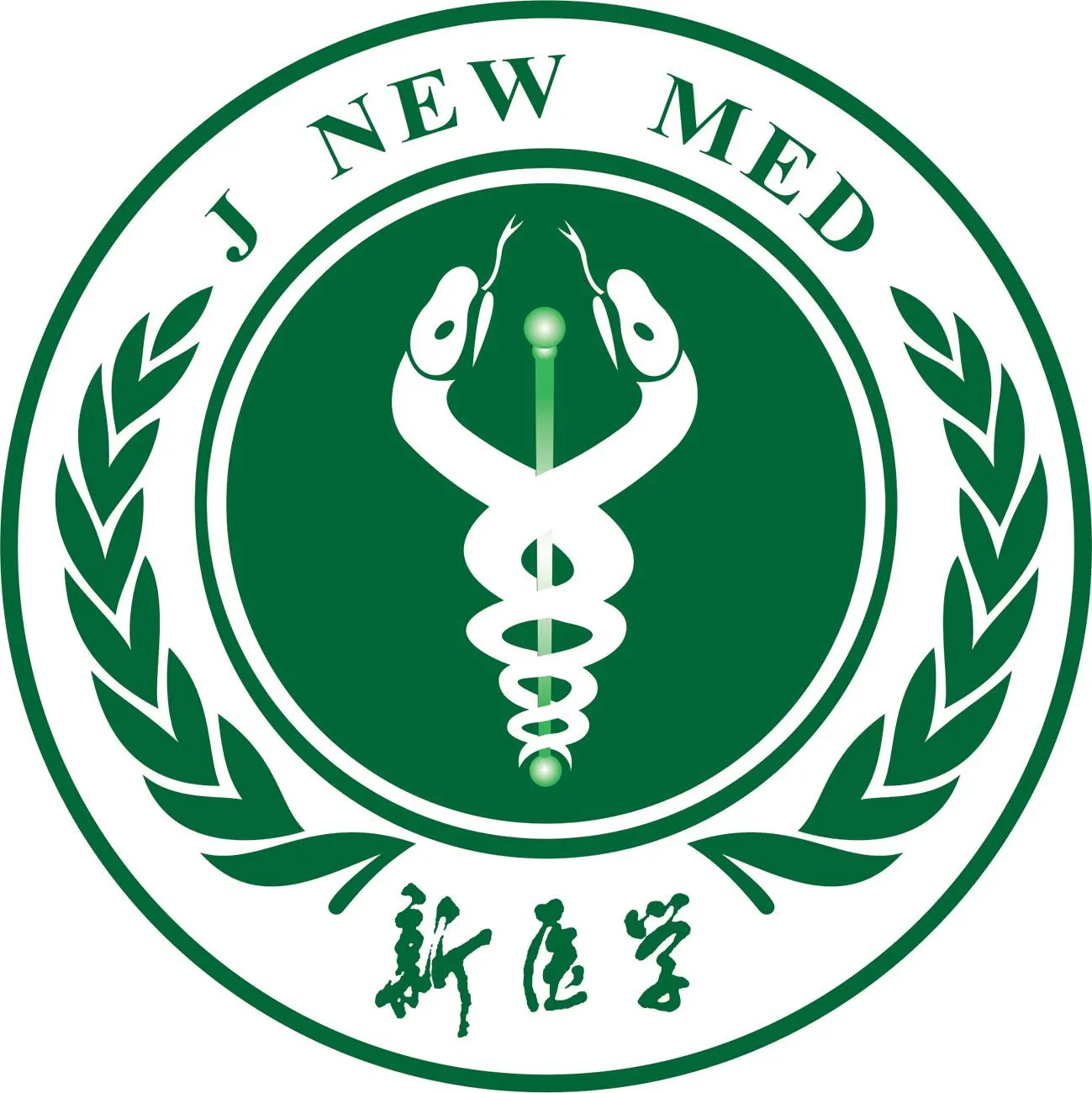Beclin-1与EZH2在肾透明细胞癌中的表达及其意义
2016-06-20范大为刘凯袁成刚杜晓媛
范大为 刘凯 袁成刚 杜晓媛
124010 锦州,辽宁医学院病理教研室(范大为,杜晓媛);124010 锦州,辽河油田总医院欢喜岭医院 (范大为,袁成刚);124010 锦州,辽河油田总医院 (刘凯)
Beclin-1与EZH2在肾透明细胞癌中的表达及其意义
范大为刘凯袁成刚杜晓媛
124010 锦州,辽宁医学院病理教研室(范大为,杜晓媛);124010 锦州,辽河油田总医院欢喜岭医院 (范大为,袁成刚);124010 锦州,辽河油田总医院 (刘凯)
【摘要】目的探讨自噬相关基因Beclin-1和果蝇Zeste同源物增强子2(EZH2)基因在肾透明细胞癌(肾癌)中的表达水平及其相关性,分析其预测肾癌预后的作用。方法收集30对肾肿瘤及癌旁肾组织新鲜标本以及133例肾癌石蜡组织标本,采用免疫组织化学染色法(免疫组化)、实时荧光定量PCR和蛋白免疫印迹法检测上述标本中Beclin-1及EZH2的表达情况,分析Beclin-1与EZH2表达的相关性,以及两者对预测肾癌术后复发及生存率的差异,并使用Cox回归分析肾癌的病理分级、TNM分期、淋巴结转移、年龄、性别与两者表达的相关性,探讨其是否为肾癌预后的影响因素。结果30对肾癌及癌旁肾组织中,肾癌组织中Beclin-1蛋白及mRNA表达水平均低于癌旁肾组织,而EZH2蛋白及mRNA表达水平均高于癌旁肾组织(P均<0.01)。133例肾癌石蜡标本中,Beclin-1阴性表达60例,阳性73例;EZH2阴性67例,阳性66例,EZH2表达与Beclin-1表达呈负相关(rs=-0.574,P<0.01)。与单纯EZH2阳性表达及Beclin-1阴性表达者相比,EZH2阳性且Beclin-1阴性者的肿瘤复发率高、生存率低(P<0.05)。肿瘤分级、分期、淋巴结状态、EZH2及Beclin-1表达水平是肾细胞癌术后复发、死亡的影响因素。结论肾癌组织中Beclin-1与EZH2表达呈明显负相关, EZH2可能参与沉默Beclin-1表达;Beclin-1低表达、EZH2高表达可能与肾癌预后不良有关,两者可能成为肾癌个体化治疗的潜在靶点。
【关键词】肾透明细胞癌;自噬相关基因;果蝇Zeste同源物增强子2;预后
肾透明细胞癌(肾癌)占成人恶性肿瘤的3%。近年肾癌的发病率较以前有所升高[1-2]。肾癌对放射治疗及化学治疗反应欠佳,手术切除是唯一可能治愈的方法,但术后有近30%的复发率[2]。对于20%初次就诊时已发生远处转移的患者,需要进行免疫或靶向治疗[1]。目前,免疫或靶向治疗的有效率约25%~35%,主要靶向分子为表皮生长因子受体[3]。要提高治疗的成功率,尚要寻找更加敏感的治疗靶点。自噬是选择性、非胱抑素依赖的程序性细胞死亡,与细胞的生长、增殖及肿瘤的发生过程关系密切[4-5]。自噬相关基因Beclin-1在不同肿瘤中的表达情况不尽相同[6]。Beclin-1的表观遗传学改变是其表达下调的主要调控机制之一[7]。果蝇Zeste同源物增强子2(EZH2)为组蛋白甲基转移酶,具有DNA甲基转移酶、组蛋白去乙酰化酶的调控作用,参与靶基因的转录抑制,促进细胞的增殖,且其参与的基因沉默机制与DNA甲基转移酶参与的基因沉默机制及组蛋白的乙酰化修饰存在交互作用。本研究检测了肾癌组织中Beclin-1与EZH2的表达水平,分析其相关性,拟初步探讨两者联合指标预测对肾癌预后的预测作用。
材料与方法
一、标本来源
收集2011年1月至2013年1月在辽河油田总医院行肾癌根治术的30对肾癌和癌旁肾组织新鲜标本,来源者男21例、女9例,年龄≤65岁17例、>65岁13例,开放手术18例、腹腔镜手术12例,肿瘤分期T1~T4分别为11、8、5、6例,肿瘤分级G1~G3级分别为9、12、9例,淋巴结转移1例。另收集2005年5月至2009年5月在辽宁医学院附属医院及辽河油田总医院进行肾癌根治术的133例患者肾癌石蜡组织标本。来源者男74例、女59例,年龄≤65岁41例、>65岁92例,开放手术42例、腹腔镜手术91例,肿瘤分期T1~T4分别为50、33、30、17例,肿瘤分级G1~G3级分别为15、52、56例,淋巴结转移23例。
二、Beclin-1、EZH2蛋白表达水平的检测
采用蛋白免疫印迹法检测,按照试剂盒说明书操作。Beclin-1抗体(美国Santa Cruz,1∶200稀释);EZH2(美国Abcam,1∶100)。以β-actin为内参照,各组所得条带灰度值与β-actin灰度值之比为蛋白相对表达水平。
三、Beclin-1、EZH2 mRNA表达水平的检测
采用实时荧光定量PCR检测,按照试剂说明书进行。即用型实时定量 PCR (qPCR) 试剂盒SYBR Green qPCR SuperMix购自日本Takara公司, PRISM®7500 快速荧光定量PCR仪购自美国ABI公司。引物序列由本课题组成员自行设计并验证,由日本Takara公司协助合成,具体为:Beclin-1上游5’-ACCGTCTCCATTCTGAAACT-3’、下游5’-ATC-TGCCTCACCCACTTTT-3’;EZH2上游5’-TGGGTGAGGCAGATGCAAAGA-3’、下游5’-CAGGTGGA-GTGAATGGTGC-3’、对照物GAPDH上游5’-AGC-GCACCATTCACTCCAC-3’、下游5’-GTGATCCGCG-GGATGTTCT-3’。
四、Beclin-1的免疫组织化学检测
检测方法遵循既往文献报道[8]。Beclin-1主要表达于细胞浆,细胞核和包膜基本无表达。EZH2在胞核及胞浆均有表达。染色强度分为4级:无阳性染色为0分,淡黄色为1分,棕黄色为2分,棕褐色为3分。每张切片至少随机选取10个高倍(200倍)镜下视野分析阳性细胞比例,每个视野至少计数100个细胞,按阳性细胞所占百分比评分:0%为0分,1%~25%为1分,26%~50%为2分,51%~75%为3分,76%~100%为4分。综合评分为染色强度积分与阳性细胞比例积分之积,本研究以综合评分≥4分为阳性,﹤4分为阴性。
五、统计学处理
结果
一、Beclin-1及EZH2在肾癌及癌旁肾组织中的蛋白表达水平
30对肾癌及癌旁肾组织中,肾癌组织中Beclin-1蛋白及mRNA表达水平均低于癌旁肾组织,而EZH2蛋白及mRNA表达水平均高于癌旁肾组织(P均<0.001),见图1。

图1 肾癌及癌旁肾组织中Beclin-1及EZH2表达水平
A:蛋白免疫印迹结果;B:实时定量 PCR结果;**P<0.01
二、肾癌组织中Beclin-1与EZH2表达的相关性分析
133例肾癌石蜡标本中,Beclin-1阴性表达60例,阳性73例;EZH2阴性67例,阳性66例,见图2。EZH2表达强度与Beclin-1表达强度呈负相关(rs=-0.574,P<0.001)。

图2 Beclin-1及EZH2在肾癌石蜡组织标本中的表达情况(免疫组织化学染色,×200)
A、B、C:正常肾组织;D、E、F:无复发肾癌组织;G、H、I:复发肾癌组织;A、D、G:Beclin-1;B、E、H:EZH2;C、F、I:苏木素-伊红染色
三、Beclin-1联合EZH2对肾癌复发及生存的预测价值
在133例肾癌石蜡标本中,Beclin-1阳性且EZH2阴性32例, Beclin-1阴性且EZH2阴性者30例,Beclin-1阳性且EZH2阳性者34例,EZH2阳性且Beclin-1阴性37例。与单纯EZH2阳性表达及Beclin-1阴性表达者相比,EZH2阳性且Beclin-1阴性者的肿瘤复发率高、生存率低(P均<0.05),见图3。

图3 Beclin-1阳性和(或)EZH2阳性对肾癌患者生存率的影响
A:4组患者的肾癌复发率比较差异有统计学意义(P=0.002);B:4组患者的病死率比较差异有统计学意义(P=0.012)
四、单因素及多因素模型的构建
对于肿瘤复发这一观察终点,单因素分析显示肿瘤分级、原发肿瘤病理分期、淋巴结状态及Beclin-1及EZH2表达水平与肾细胞癌术后复发密切相关。进一步多因素Cox回归分析显示肿瘤分级、肿瘤分期、淋巴结状态、EZH2及Beclin-1表达水平是肾细胞癌术后复发的独立危险因素,见表1。对于肿瘤死亡这一观察终点,单因素分析显示肿瘤分级、原发肿瘤病理分期、淋巴结状态及Beclin-1及EZH2表达水平与肾细胞癌术后复发密切相关。进一步多因素Cox回归分析显示肿瘤分级、肿瘤分期、淋巴结状态、EZH2及Beclin-1表达水平是肾细胞癌术后死亡的独立危险因素,见表2。

表1 肾癌术后首次复发独立危险因素单因素及多因素分析
讨论
随着现代分子生物学技术的不断进展,多个与肾癌相关的分子如VHL、缺氧诱导因子、血管内皮生长因子、转化生长因子、碳酸苷酶、红细胞生成素、Ki-67相继被研究和证实,初步揭示了其在肾癌的早期诊断、预测肾癌复发转移风险及生存期的重要作用[9-16]。但上述分子指标对肾癌的早期诊断及预后预测的准确性有限,但仍然无法准确判断肾癌患者的复发、进展及转移的风险;也无法解决肾癌细胞对化学治疗药物产生耐药性的缺点。一些兼具更高敏感性和特异性的分子标记有待进一步的探讨。

表2 肾癌术后死亡的独立危险因素单因素分析及多因素模型
Beclin-1基因是酵母ATG6的同系物,是介导哺乳动物自噬的特异基因[6]。已经证实通过上调Beclin-1在哺乳动物细胞中的表达可以激活自噬发生,进而改变其表型。Beclin-1是自噬体形成过程中的一个关键分子,它介导其它自噬蛋白定位于吞噬泡中,从而调控哺乳动物自噬体的形成与成熟。在自噬过程中Beclin-1的表达水平上调[6]。本研究发现,Beclin-1在肾癌组织中的蛋白及mRNA表达水平均低于癌旁肾组织,Beclin-1低表达的肾癌患者复发率、进展率较高,生存率较低。多因素分析显示,Beclin-1基因是肾癌术后复发、转移及生存的独立危险因素。提示Beclin-1可能是肾癌的重要预后因子,为肾癌靶向治疗提供了新的治疗靶点。Beclin-1在恶性肿瘤表达下调可能与其自身表观遗传学改变密切相关[7]。表观遗传改变主要包括DNA甲基化、非编码 RNA调控及组蛋白修饰。Beclin-1在各种肿瘤中表达下调的原因及机制仍未阐明。
EZH2属于PcG家族蛋白,是PRC2转录抑制复合体的核心组成部分,发挥基因沉默的作用[17]。EZH2自身还有组蛋白甲基化酶功能,使目的基因特定区域组蛋白甲基化,协同DNA甲基化转移酶介导的CpG岛甲基化,使目的基因启动子区核小体紧缩,转录失活[18-19]。有报道EZH2在肾癌中过度表达[20]。结合文献资料和课题组研究结果,我们设想Beclin-1在肾癌中下调可能是因为EZH2过度表达所致。本研究显示,肾癌组织中EZH2蛋白及mRNA表达水平均高于癌旁肾组织Beclin-1,在肾癌中的表达与EZH2呈负相关,EZH2阳性且Beclin-1阴性者的肿瘤复发率及病死率高于单纯EZH2阳性表达及Beclin-1阴性表达者,提示Beclin-1低表达、EZH2高表达可能与肾癌预后有关,两者间具体关系不明,有待更深入的研究。
综上所述, Beclin-1及EZH2表达水平是肾癌术后复发及生存的独立危险因素,为肾癌靶向治疗提供新的潜在治疗靶点。肾癌组织中Beclin-1与EZH2表达呈负相关,转录抑制因子EZH2可能与肾癌中Beclin-1基因沉默有关,这为后续研究Beclin-1在肾癌中低表达的分子机制提供了理论基础。
参考文献
[1]Jemal A, Bray F, Center MM, Ferlay J, Ward E, Forman D. Global cancer statistics.CA Cancer J Clin,2011,61(2):69-90.
[2]Bianchi M, Gandaglia G, Trinh QD, Hansen J, Becker A, Abdollah F, Tian Z, Lughezzani G, Roghmann F, Briganti A, Montorsi F, Karakiewicz PI,Sun M.A population-based competing-risks analysis of survival after nephrectomy for renal cell carcinoma.Urol Oncol,2014,32(1):46.e1-e7.
[3]Bagcchi S.Sunitinib still first-line therapy for metastatic renal cancer.Lancet Oncol,2014,15(10):e420.
[4]Orzechowski A, Bettuzzi S, Pawlikowska P, Pająk B.Control of autophagy in cancer.Biomed Res Int, 2015,2015:698740.
[5]Peter ME. Programmed cell death: apoptosis meets necrosis. Nature,2011,471(7338):310-312.
[6]Wrighton KH.Autophagy: kinase crosstalk through beclin 1.Nat Rev Mol Cell Biol,2013,14(7):402-403.
[7]Li Z, Chen B, Wu Y, Jin F, Xia Y, Liu X.Genetic and epigenetic silencing of the beclin 1 gene in sporadic breast tumors.BMC Cancer,2010,10:98.
[8]Jiang Y, Zhang W, Kondo K, Klco JM, St Martin TB, Dufault MR, Madden SL, Kaelin WG Jr, Nacht M.Gene expression profiling in a renal cell carcinoma cell line: dissecting VHL and hypoxia-dependent pathways.Mol Cancer Res,2003,1(6):453-462.
[9]Phuoc NB, Ehara H, Gotoh T, Nakano M, Yokoi S, Deguchi T, Hirose Y. Immunohistochemical analysis with multiple antibodies in search of prognostic markers for clear cell renal cellcarcinoma. Urology, 2007,69(5):843-848.
[10]Tsutsumi H, Miyamoto C, Furuichi Y, Yoshiike M, Nozawa S, Iwamoto T. VHL tumor suppressor gene: its mutation and protein level in renal cell carcinoma.Oncol Rep,2003,10(5):1357-1361.
[11]赵磊,于德新. 肾癌预后分子标记物研究新进展.临床泌尿外科杂志,2010,25(1): 64-71.
[12]Garcia-Roig M, Ortiz N, Lokeshwar V.Molecular marker for predicting treatment response in advanced renal cell carcinoma: does the promise fulfillclinical need? Curr Urol Rep,2014,15(1):375.
[13]Lidgren A, Hedberg Y, Grankvist K, Rasmuson T, Vasko J, Ljungberg B.The expression of hypoxia-inducible factor 1alpha is a favorable independent prognostic factor in renal cell carcinoma.Clin Cancer Res,2005,11(3):1129-1135.
[14]Ljungberg BJ, Jacobsen J, Rudolfsson SH, Lindh G, Grankvist K, Rasmuson T.Different vascular endothelial growth factor (VEGF), VEGF-receptor 1 and -2 mRNA expression profiles betweenclear cell and papillary renal cell carcinoma.BJU Int,2006,98(3):661-667.
[15]Bui MH, Visapaa H, Seligson D, Kim H, Han KR, Huang Y, Horvath S, Stanbridge EJ, Palotie A, Figlin RA, Belldegrun AS.Prognostic value of carbonic anhydrase IX and KI67 as predictors of survival for renal clear cell carcinoma.J Urol,2004,171(6 Pt 1):2461-2466.
[16]Rioux-Leclercq N, Turlin B, Bansard J, Patard J, Manunta A, Moulinoux JP, Guillé F, Ramée MP, Lobel B.Value of immunohistochemical Ki-67 and p53 determinations as predictive factors of outcome in renal cellcarcinoma.Urology,2000,55(4):501-505.
[17]Chase A, Cross NC.Aberrations of EZH2 in cancer.Clin Cancer Res,2011,17(9):2613-2618.
[18]Yoo KH, Hennighausen L.EZH2 methyltransferase and H3K27 methylation in breast cancer.Int J Biol Sci, 2012,8(1):59-65.
[19]Chang CJ, Hung MC.The role of EZH2 in tumour progression.Br J Cancer,2012,106(2):243-247.
[20]Liu L, Xu Z, Zhong L, Wang H, Jiang S, Long Q, Xu J, Guo J. Prognostic value of EZH2 expression and activity in renal cell carcinoma: a prospective study.PLoS One,2013,8(11):e81484.
(本文编辑:林燕薇)

Expression and significance of Beclin-1 and EZH2 in renal cell carcinoma
FanDawei,LiuKai,YuanChenggang,DuXiaoyuan.
LiaoningMedicalColleage,Jinzhou124010,ChinaCorrespondingauthor,DuXiaoyuan,E-mail:351844459@qq.com
【Abstract】ObjectiveTo investigate the expression levels and clinical significance of Beclin-1 and enhancer of zeste homolog 2 (EHZ2) in renal clear cell carcinoma (kidney cancer), aiming to evaluate the roles of Beclin-1 and EHZ2 in the prognosis of kidney cancer. MethodsWestern blot, real-time PCR and immunohistochemical staining were employed to detect the expression levels of Beclin-1 and EZH2 in renal tumors and paired adjacent normal tissues from 30 patients with renal clear cell carcinoma and paraffin-embedded specimens from 133 cases of kidney cancer, respectively. The correlation between EZH2 and Beclin-1 was analyzed. The roles of Beclin-1 and EZH2 in the prognosis of postoperative recurrence and survival were evaluated. The relationship between pathological grading, TNM staging, lymph node metastasis, age, gender and the expression of Beclin-1 and EZH2 was analyzed using Cox regression model, aiming to confirm the roles of Beclin-1 and EZH2 in the prognosis of kidney cancer. ResultsIn 30 cases of renal clear cell carcinoma and paired normal adjacent tissues, the expression of Beclin-1 at both mRNA and protein levels was significantly lower whereas the expression of EZH2 at both mRNA and protein levels was considerably higher compared with those in the adjacent normal renal tissues (all P<0.05). In 133 paraffin-embedded specimens, 60 were negative for Beclin-1 and 73 were positive for Beclin-1 expression, 67 were negative for EZH2 and 66 were positive for EZH2. The expression level of Beclin-1 was negatively correlated with EZH2 expression (rs=-0.574,P<0.01). Compared with patients who were positive for EZH2 or negative for Beclin-1, those with positive EZH2 and negative Beclin-1 had higher recurrence rate and shorter survival(P<0.05). Tumor grading and staging, lymph node status, EZH2 and Beclin-1 expression were influential factors of postoperative recurrence and survival in patients with renal clear cell carcinoma. ConclusionThe expression level of Beclin-1 is negatively correlated with EZH2 expression in renal cell carcinoma tissues. EZH2 probably participates in the silencing of Beclin-1 expression. Low expression of Beclin-1 and high expression of EZH2 might be associated with the prognosis of kidney cancer. EZH2 and Beclin-1 probably serve as potential targets of individualized therapy of renal cancer.
【Key words】Renal clear cell carcinoma; Autophagy-associated gene; EZH2;Prognosis
DOI:10.3969/j.issn.0253-9802.2016.05.011
(收稿日期:2016-03-31)
·基础研究论著·
通讯作者,杜晓媛,E-mail:351844459@qq.com
